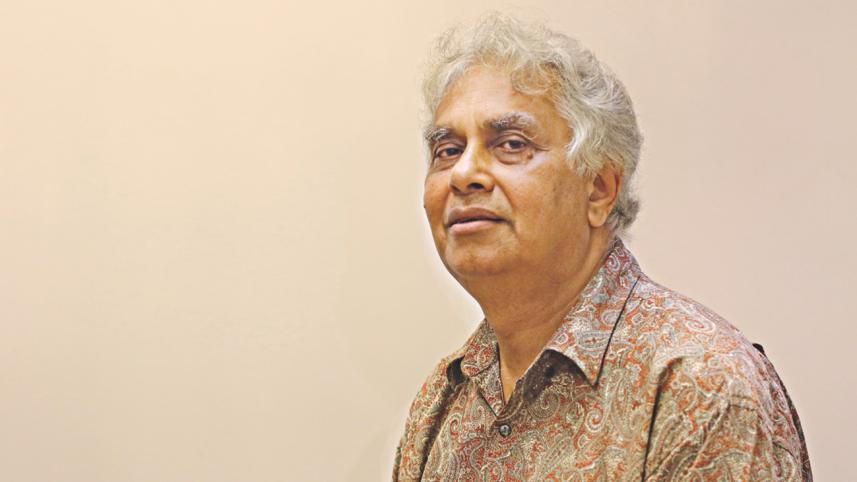An artist extraordinaire

Nature has its own melody, perceptible to a sensitive artist. The music of nature in its infinite splendour is a constant inspiration for internationally renowned artist Kazi Ghiyasuddin. He captures nature's underlying harmony of colours in his paintings.
The first Monbusho scholar from Bangladesh, he went to Japan to pursue his Ph D when he was a young teacher at the Department of Drawing and Painting of the Institute of Fine Arts (now Faculty of Fine Art), University of Dhaka. He was also an art teacher in Japan. Teaching did not have an enduring appeal for this prolific creator of art. The true professional artist, who has an illustrious career of over five decades, still works eight hours a day.

A few days ago, this correspondent saw him hard at work despite scorching heat at his vast studio in Savar, Dhaka. Watercolour is his favourite media. He is the creator of many fascinating oils. At present, the contemporary master is busy completing several life-sized oils for his upcoming show to be held next month at the famous Tokyo Opera City Art Gallery.
“Art is not a business. Why do I paint? I paint as I feel an inner urge. If you cannot feel nature and hold its magnanimous beauty, you can never become an artist. Present day artists have deviated from this spirit. When I was a first year (Honours) student, I would frequently go for outdoor works with artist Monirul Islam, Mahbub and our teachers Rafiqun Nabi and Mustafa Monwar,” said Kazi Ghiyasuddin.
“Merely copying nature is not creation. I am inspired by the words of Paul Klee, who said that somebody will be a good painter, not creator. Turner's realistic watercolours are fabulous, but, I am moved by the abstract works of Paul Klee. Artist Monirul Islam has a vast volume of watercolour. An exhibition of his works would reveal the secret of watercolour and young artists would benefit,” he added.
Watercolour evokes the feelings of poetry while oil delineates the magnanimity of an epic or a vast novel. Kazi Ghiyasuddin adeptly works in both media. He would attach excerpts from the poems of Tagore, Jibanananda Das and others as calligraphy in his works. He creates constructive composition observing the beauty of landscapes and forms of nature. His watercolours simultaneously evoke a blend of Eastern and Western taste. He takes forms from nature, but, creates his own. What is distinctive in his work is the technique and treatment of colour. At present he is deconstructing forms and spreading minimal colours on canvas for his fifth art publication.
Apart from realistic works, his art contains geometric forms, painting within painting, subtle game of light and shade, polar view of the earth, surrealism and absolute abstraction. He completes each of his watercolours in dry method, applying colour layer by layer with importantly keeping paper white to create depth. His treatment of oil colours glows like the rays of serene beauty.
“I paint for my own delight. I want to put together image after image to create an orchestra. Sometimes a cloudy sky looks up with a flash of bright sunlight. The midday sunshine makes the woods on the riverbank look greener. At dusk that turns more violet or dark green. If these images are deemed surrealistic, then my paintings can also be said to be on the verge of surrealism,” explains the master.
He has four art book publications to his credit. His maiden publication “Spirit of Bengal” is an ode to the motherland. A painstaking treatment of nature, heritage, poetry, rhythm, feminine grace, and more embellish the book. “Sound of Nature” was published by NHK Publishing, Japan which published one of the books of Tagore. The third one was also published in Japan.
The fourth book is jointly published by Bengal Foundation and Skira. Titled, “Kazi Ghiyasuddin: Contemporary Masters of Bangladesh”, the book earned him international acclaim and fame. Many art connoisseurs, critics and organisations wrote him letters appreciating his works.
Rosa Maria Falvo, editor of the book, noted “Beautifully illustrated, this is the first volume in the series on contemporary artists from Bangladesh. On this rare creative journey, Kazi Ghiyasuddin draws his inspiration from nature to project his desire for harmony and peace. Producing richly textured canvases, his unique style resonates with delicate, inwardly expanding applications of paint. His early, more formal works have evolved into suggestive dream-like contemplations. As if conducting a sensory orchestra, Ghiyasuddin has melded two distinct cultures and aesthetics.
This book showcases over 200 colour plates tracing the artist's personal vision over three decades of change in Bangladesh, and will appeal to anyone interested in contemporary art in South Asia; particularly collectors, curators, academics, and artists.”Kyuryudo Art-Publishing Co. Ltd. will publish his fifth book featuring his recent masterpieces. He has 100 solo exhibits to his credit. Of them, 75 were held in Japan. His works are in the collection of many art museums. Asian Art Museum has collected most of his works.




 For all latest news, follow The Daily Star's Google News channel.
For all latest news, follow The Daily Star's Google News channel.
Comments